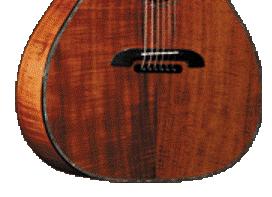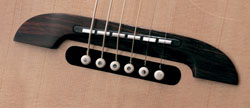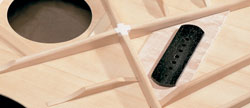To expand a little on what Mattia said:
If the strings came right off at the level of the top surface, the only stress on the glue line would be in shear. In 'The New Science of Strong Materials; or why you don't fall through the floor', the author shows how this sort of stress is distributed in a glue line. If you glue two sticks together and pull on them (which is the same thing) the stress is highest at the front and back edges of the glue line, as seen along the direction of pull, and low in the middle. The low level is set by the strength and elasticity of the glue. The area under the curve equals the total force. The joint fails if the stress at the leading or trailing edges exceeds the strength of the glue line. Making the joint longer along the line of pull puts more of the total stress into the low level part of the curve, and thus cuts down on the stress at the edges. That's why the 'belly' bridge holds the extra tension of steel strings where a classical-type bridge usually won't, even though the 'belly' has a smaller total gluing area.
Of course, the strings _can't_ come off the bridge right on the surface of the top: you couldn't play the guitar! The fact that the strings are above the top puts a torque on the bridge: it's as if it's trying to rotate around the line where the saddle would hit the top, roughly. As Mattia pointed out, the glue line in front of the saddle is being compressed, and that would stay put even if there was no glue, if torque were the only issue. The back of the bridge is being lifted off the top, so the glue line there is taking a peeling stress. Very few glues are much very good at resisting peeling: once you get that edge loose the rest is a piece of cake generally.
So, when you add up the shear stress and the peeling stress, you can see that the back edge of the bridge is the critical point. The front-to-back width of the bridge establishes the level of the shear stress, and the little bellcrank lever of the saddle top to bottom fulcrum, and the distance from there to the back of the bridge, sets the peeling stress. Length behind the saddle does you more good for peeling than length in front. Other than that, there's no particular reason not to put the saddle further back that I can think of. It's not going to 'damp' the sound for that reason, although, of course, you will need to use a bigger bridge.
IMO, mass is more important then footprint area in terms of tone. Mass cuts down treble by limiting acelleration. It's easy enough to make a big, light bridge by using a less dense wood, such as walnut, and this can give you great treble response. For one thing, in it's fuunction as a top brace, it's reasonably stiff and light.
|



 I just had an idea for a prototype that I think I will work on this year. A configeration somewhat like the Yairi direct coupling system except pinless.
I just had an idea for a prototype that I think I will work on this year. A configeration somewhat like the Yairi direct coupling system except pinless.
